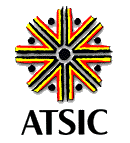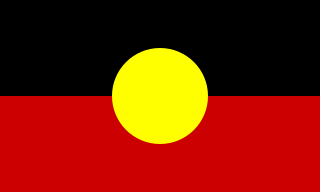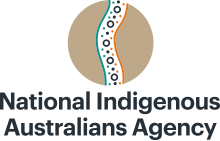
The Aboriginal and Torres Strait Islander Commission (ATSIC) (1990–2005) was the Australian Government body through which Aboriginal Australians and Torres Strait Islanders were formally involved in the processes of government affecting their lives, established under the Hawke government in 1990. A number of Indigenous programs and organisations fell under the overall umbrella of ATSIC.

The Australian Aboriginal flag is an official flag of Australia that represents Aboriginal Australians. It was granted official status in 1995 under the Flags Act 1953, together with the Torres Strait Islander flag, in order to advance reconciliation and in recognition of the importance and acceptance of the flag by the Australian community. The two flags are often flown together with the Australian national flag.
The Office of Indigenous Policy Coordination (OIPC) was the Australian Government-led unit for the coordination of policy, programs and services for Indigenous Australians from July 2004 to August 2011.

The Department of the Prime Minister and Cabinet (PM&C) is a department of the Australian Government with broad-ranging responsibilities; notably, intergovernmental and whole of government policy coordination and assisting the prime minister of Australia in managing the Federal Cabinet. The PM&C was established in 1971 and traces its origins back to the Prime Minister's Department established in 1911.

The Australian National Aboriginal and Torres Strait Islander Education Policy (AEP) is a national policy adopted by the Government of Australia by each State and Territory government. The policy was first introduced in 1989 and is the foundation of education programs for all Indigenous Australians.
Indigenous Australian self-determination, also known as Aboriginal Australian self-determination, is the power relating to self-governance by Aboriginal and Torres Strait Islander peoples in Australia. It is the right of Aboriginal and Torres Strait Islander peoples to determine their own political status and pursue their own economic, social and cultural interests. Self-determination asserts that Aboriginal and Torres Strait Islander peoples should direct and implement Aboriginal and Torres Strait Islander policy formulation and provision of services. Self-determination encompasses both Aboriginal land rights and self-governance, and may also be supported by a treaty between a government and an Indigenous group in Australia.
The National Native Title Tribunal (NNTT) is an independent body established under the Native Title Act 1993 in Australia as a special measure for the advancement and protection of Aboriginal and Torres Strait Islander peoples. It manages applications for and administration of native title in Australia.

The National Congress of Australia's First Peoples was the national representative body for Aboriginal and Torres Strait Islander Australians from 2009 to 2019.

Kenneth George Wyatt is an Australian former politician. He was a member of the House of Representatives from 2010 to 2022, representing the Division of Hasluck for the Liberal Party. He is the first Indigenous Australian elected to the House of Representatives, the first to serve as a government minister, and the first appointed to cabinet.

The Minister for Indigenous Australians in the Government of Australia is a position which holds responsibility for affairs affecting Indigenous Australians. Previous ministers have held various other titles since the position was created in 1968, most recently Minister for Indigenous Affairs. Since July 2024, the position has been held by Malarndirri McCarthy in the Albanese ministry.
The Department of Reconciliation and Aboriginal and Torres Strait Islander Affairs was an Australian government department that existed between January and November 2001, concerned with the Aboriginal and Torres Strait Islander peoples and the government policy of reconciliation in Australia.
The Closing the Gap framework is a strategy by the Commonwealth and state and territory governments of Australia that aims to reduce disparity between Aboriginal and Torres Strait Islander peoples and non-Indigenous Australians on key health, education and economic opportunity targets. The strategy was launched in 2008 in response to the Close the Gap social justice movement, and revised in 2020 with additional targets and a refreshed strategy.
Pat Turner is an Aboriginal Australian of Gudanji-Arrernte heritage who has worked as a civil administrator for policies which guarantee the right to self-determination for Indigenous people. She was awarded the Order of Australia in 1990 for her service.

Jody Broun is an Indigenous Australian artist and activist with a long-standing career, most recently with her current position being Chief Executive Officer of the National Indigenous Australians Agency. She has completed a Diploma of Teaching, Bachelor of Education and a Masters in Philosophy. In 1998 she was awarded first prize in the Telstra National Aboriginal and Torres Strait Islander Art Award for her artwork "White Fellas Come To Talk Bout Land" and in 2005 Broun was awarded first place in the Canberra Art Prize for her artwork "Half-Time Game". Along with these major awards Broun has displayed many artworks in solo and group exhibitions, winning many other awards, and grants. Broun is a Yindjibarndi woman with family connection from the Pilbara region in North Western Australia, and is known for her dedication to Indigenous communities in Australia.
Kirstie Parker is a Yuwallarai journalist, policy administrator and Aboriginal Australian activist. From 2013 to 2015 she served as the co-chair of the National Congress of Australia's First Peoples and during her tenure pressed for policies that allowed Aboriginal and Torres Strait Islander Australians to gain the ability for self-determination.

The Aboriginal and Torres Strait Islander Voice, also known as the Indigenous Voice to Parliament, the First Nations Voice or simply the Voice, was a proposed Australian federal advisory body to comprise Aboriginal and Torres Strait Islander people, intended to represent the views of Indigenous communities. The Voice as proposed by the Albanese government would have had the power to make representations to the Parliament of Australia and executive government on matters relating to Indigenous Australians. The specific form of the Voice was to be determined by legislation passed by Parliament had the referendum succeeded.
Constitutional recognition of Indigenous Australians refers to various proposals for changes to the Australian Constitution to recognise Indigenous Australians in the document. Various proposals have been suggested to symbolically recognise the special place Indigenous Australians have as the first peoples of Australia, along with substantial changes, such as prohibitions on racial discrimination, the protection of languages and the addition of new institutions. In 2017, the Uluru Statement from the Heart was released by Indigenous leaders, which called for the establishment of an Indigenous Voice to Parliament as their preferred form of recognition. When submitted to a national referendum in 2023 by the Albanese government, the proposal was heavily defeated.
The Aboriginal Legal Rights Movement (ALRM) is an ATSILS in South Australia, providing pro bono legal services to Aboriginal and Torres Strait Islander peoples in the state.
The Indigenous Advisory Council (IAC), also known as the Prime Minister's Indigenous Advisory Council, existed between 2013 and 2019.









